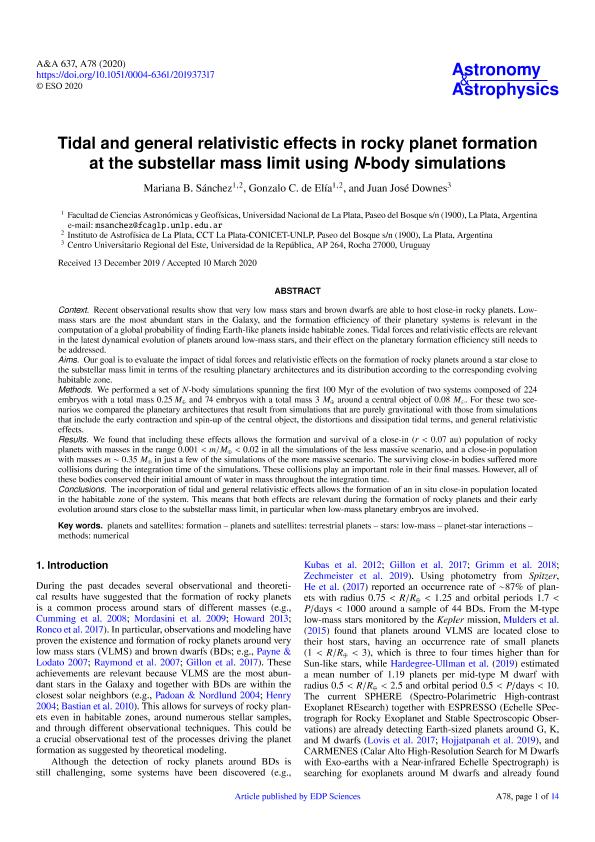Mostrar el registro sencillo del ítem
dc.contributor.author
Sánchez, María Belén

dc.contributor.author
de Elia, Gonzalo Carlos

dc.contributor.author
Downes, J. J.
dc.date.available
2021-10-20T14:00:59Z
dc.date.issued
2020-03
dc.identifier.citation
Sánchez, María Belén; de Elia, Gonzalo Carlos; Downes, J. J.; Tidal and general relativistic effects in rocky planet formation at the sub-stellar mass limit using N-body simulations; EDP Sciences; Astronomy and Astrophysics; 637; A78; 3-2020; 1-14
dc.identifier.issn
0004-6361
dc.identifier.uri
http://hdl.handle.net/11336/144429
dc.description.abstract
Context. Recent observational results show that very low mass stars and brown dwarfs are able to host close-in rocky planets. Low-mass stars are the most abundant stars in the Galaxy and the formation efficiency of their planetary systems is relevant in the computation of a global probability of finding Earth-like planets inside habitable zones. Tidal forces and relativistic effects are relevant inthe latest dynamical evolution of planets around low-mass stars and their effect on the planetary formation efficiency still needs to beaddressed.Aims. Our goal is to evaluate the impact of tidal forces and relativistic effects on the formation of rocky planets around a star close tothe sub-stellar mass limit, in terms of the resulting planetary architectures and its distribution according to the corresponding evolving habitable zone.Methods. We performed a set of N-body simulations spanning the first 100 Myr of the evolution of two systems composed respectively by 224 embryos with a total mass 0.25M_earth and 74 embryos with a total mass 3 M_earth around a central object of 0.08 M_sun . For both scenarios, we compared the planetary architectures that result from simulations that are purely gravitational with those fromsimulations that include the early contraction and spin up of the central object, the distortions and dissipation tidal terms and generalrelativistic effects.Results. We found that the inclusion of these effects allow the formation and survival of a close-in (r < 0.07 au) population of rockyplanets with masses in the range 0.001 < m/M_earth < 0.02 in all the simulations of the less massive scenario, and a close-in populationwith masses m < 0.35 M_earth in just few of the simulations of the more massive scenario. The surviving close-in bodies suffered highnumber of collisions along the integration time of the simulations which play an important role in their final masses. However, all ofthem conserved their initial amount of water in mass along the integration time.Conclusions. The incorporation of tidal and general relativistic effects allow the formation of an in-situ close-in population located inthe habitable zone of the system. Thus, both effects are relevant during the formation of rocky planet and their early evolution aroundstars close to the sub-stellar mass limit, in particular when low-mass planetary embryos are involved.
dc.format
application/pdf
dc.language.iso
eng
dc.publisher
EDP Sciences

dc.rights
info:eu-repo/semantics/openAccess
dc.rights.uri
https://creativecommons.org/licenses/by-nc-sa/2.5/ar/
dc.subject
PLANETS AND SATELLITES: FORMATION
dc.subject
PLANETS AND SATELLITES: TERRESTRIAL PLANETS
dc.subject
STARS: LOW-MASS
dc.subject
PLANET-STAR INTERACTIONS
dc.subject
METHODS: NUMERICAL
dc.subject.classification
Astronomía

dc.subject.classification
Ciencias Físicas

dc.subject.classification
CIENCIAS NATURALES Y EXACTAS

dc.title
Tidal and general relativistic effects in rocky planet formation at the sub-stellar mass limit using N-body simulations
dc.type
info:eu-repo/semantics/article
dc.type
info:ar-repo/semantics/artículo
dc.type
info:eu-repo/semantics/publishedVersion
dc.date.updated
2021-09-06T17:49:26Z
dc.journal.volume
637
dc.journal.number
A78
dc.journal.pagination
1-14
dc.journal.pais
Francia

dc.journal.ciudad
Paris
dc.description.fil
Fil: Sánchez, María Belén. Universidad Nacional de La Plata. Facultad de Ciencias Astronómicas y Geofísicas; Argentina. Consejo Nacional de Investigaciones Científicas y Técnicas. Centro Científico Tecnológico Conicet - La Plata. Instituto de Astrofísica La Plata. Universidad Nacional de La Plata. Facultad de Ciencias Astronómicas y Geofísicas. Instituto de Astrofísica La Plata; Argentina
dc.description.fil
Fil: de Elia, Gonzalo Carlos. Universidad Nacional de La Plata. Facultad de Ciencias Astronómicas y Geofísicas; Argentina. Consejo Nacional de Investigaciones Científicas y Técnicas. Centro Científico Tecnológico Conicet - La Plata. Instituto de Astrofísica La Plata. Universidad Nacional de La Plata. Facultad de Ciencias Astronómicas y Geofísicas. Instituto de Astrofísica La Plata; Argentina
dc.description.fil
Fil: Downes, J. J.. Universidad de la Republica. Centro Universitario Regional del Este.; Uruguay
dc.journal.title
Astronomy and Astrophysics

dc.relation.alternativeid
info:eu-repo/semantics/altIdentifier/doi/http://dx.doi.org/10.1051/0004-6361/201937317
dc.relation.alternativeid
info:eu-repo/semantics/altIdentifier/url/https://www.aanda.org/articles/aa/full_html/2020/05/aa37317-19/aa37317-19.html
Archivos asociados
